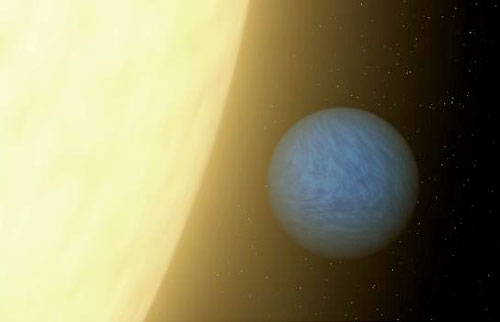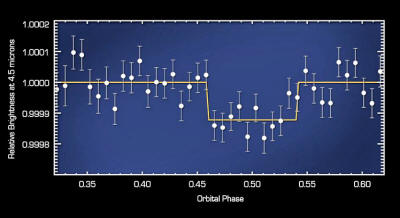|

by Michael Salla
May 15, 2012
from
ExopoliticsInstitute Website
For the first time, NASA has been able to detect infrared light from
a rocky “super-earth” variety of
exoplanets.
The
Spitzer Space Telescope detected
infrared light from the exoplanet “55 Cancri e” which has a rocky
core and is nearly twice the Earth’s diameter, and eight times its
mass.
While 55 Cancri e is much too close to
its sun - 55 Cancri A - to sustain life as we know it, the detection
is a historic first for NASA.

(PLACE MOUSE ON ABOVE
IMAGE)
An artist's concept
of 55 Cancri e,
a hot "super-Earth"
that orbits its sun every 18 hours.
Credit: NASA
How to See a Super Earth
NASA's Spitzer Space Telescope was able to
detect a super Earth's direct light for the
first time using its sensitive heat-seeking
infrared vision.
Super Earths are more
massive than Earth but lighter than gas
giants like Neptune.
As this artist's
concept shows, in visible light, a planet is
lost in the glare of its star (top view).
When viewed in infrared, the planet becomes
brighter relative to its star.
This is
largely due to the fact that the planet's
scorching heat blazes with infrared light.
Even on our own bodies emanate more infrared
light than visible due to our heat.
Spitzer cannot distinguish between the
planet and star - it just sees the total
light of the system.
However, its infrared
eyes can see the dip in total light that
occurs as a planet passes behind its star
(the dip is minuscule when viewed in visible
light).
The resulting drop then reveals how
much direct light comes from the planet
itself.
This information can be used to
determine a planet's temperature, and in
some cases, composition.
For 55 Cancri e,
the Spitzer observations indicated that the
planet is very dark and that its sun-facing
side is scorching hot, about 2,000 kelvins
(3,140 degrees Fahrenheit).
The detection of infrared light on the
super-earth category of exoplanets, prime candidates for finding
extraterrestrial life, makes possible the discovery of alien cities
in distant solar systems.
On May 8 NASA
announced:
“NASA's Spitzer Space Telescope has
detected light emanating from a "super-Earth" beyond our solar
system for the first time. While the planet is not habitable,
the detection is a historic step toward the eventual search for
signs of life on other planets.”
According to Dario Borghino from Gizmag:
“This marks the first time that
light has been detected from a planet of such a small size, and
the find is telling astrophysicists where to look in their
search for signs of life on planets beyond our own.”

The plot shows
how the infrared light from the 55 Cancri system,
both the star and
planet, changed as the planet passed behind its star. Credit NASA.
The plot shows how the infrared light from
the 55 Cancri system, both the star and
planet, changed as the planet passed behind
its star. When the planet disappeared, the
total light dropped, and then increased back
to normal levels as the planet circled back
into view. The drop indicated how much light
came directly from the planet itself. This
type of information is important for
studying the temperatures and compositions
of planetary atmospheres beyond our own.
The Spitzer Space Telescope was launched
by NASA in 2003 and studies the universe in infrared light.
In contrast to the Kepler Space
Telescope that studies how distant stars dim as exoplanets cross in
front of them, Spitzer analyzes infrared light directly from the
exoplanet itself. Basically, as the exoplanet goes behind the sun,
the total infrared light from the sun and exoplanet dims.
In the NASA statement announcing the
finding, the infrared light coming from both “55 Cancri e” and its
sun were analyzed in the attached table (see slideshow). As 55
Cancri e” dropped behind its sun, the total thermal emission
dropped, and increased when the exoplanet appeared again in its
orbit.
This raises the question, could Spitzer detect a large
extraterrestrial metropolis giving off heat in a distant world?
We can look for an answer from Dr.
William Danchi, Spitzer program scientist who states:
The radiation that is measured is in
the infrared, which is sensitive to the composition as well as
temperature of the atmosphere of the planet. Spitzer was able to
measure such a small diameter planet because it was hot, and hot
objects emit exponentially more photons that cool objects. It
would be much harder to detect a small, cool planet.
An earth like planet in a distant solar
system orbiting the habitable region of its solar system, would be
much cooler than 55 Cancri e which is much closer to its sun, but,
-
What if the habitable exoplanet
was covered by very large extraterrestrial cities generating
vast amounts of heat?
-
Could the thermal infrared
signature of an alien New York City be seen using the
detection method pioneered by the Spitzer telescope?

Infrared satellite
image of New York City, USA.
While Spitzer may lack the detection
sophistication to measure the thermal signature of large alien
metropolises, its replacement, the James Webb Space Telescope is
being promoted as having such a capacity.
According to NASA:
The [Spitzer] spacecraft is
pioneering the study of atmospheres of distant planets and
paving the way for NASA's upcoming James Webb Space Telescope to
apply a similar technique on potentially habitable planets.
The James Webb telescope launches in
2018, until then, we will have to rely on the Spitzer telescope
which officially retires in 2014, to find an alien New York City.
|



